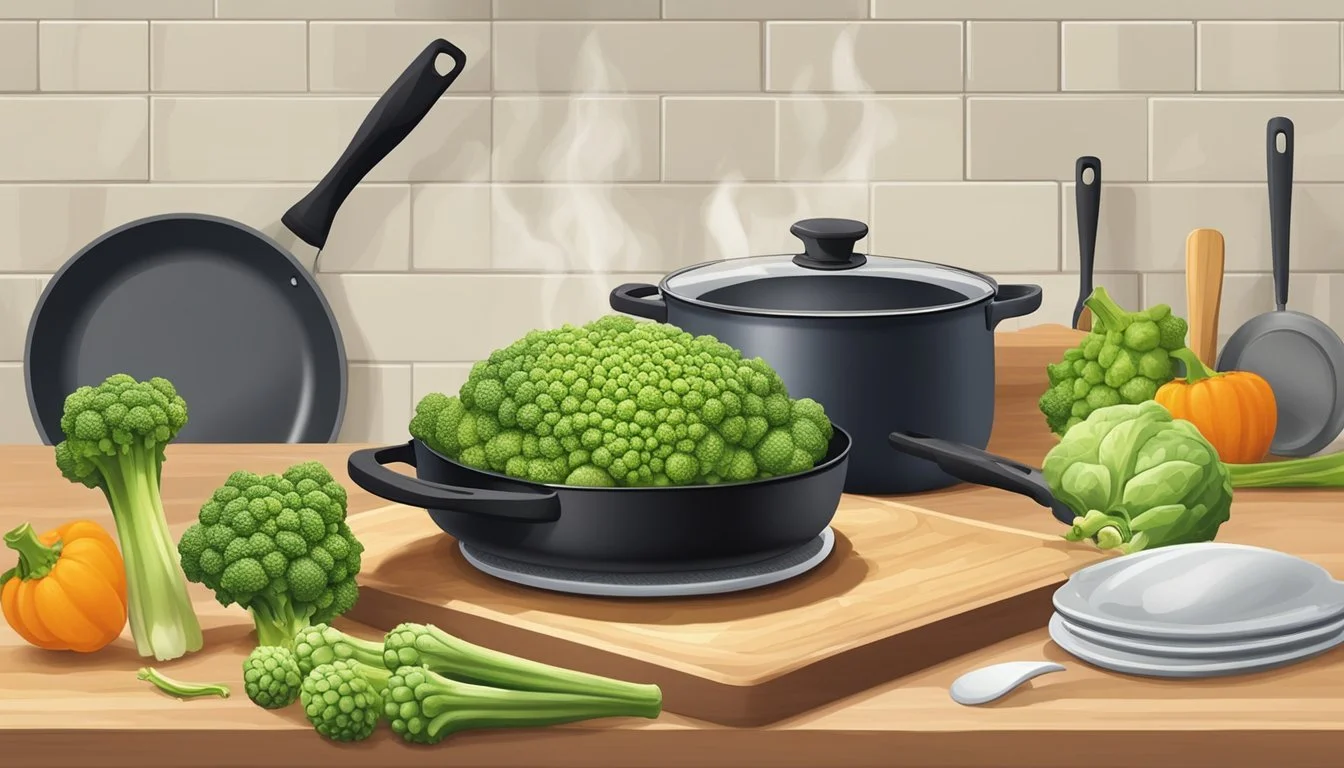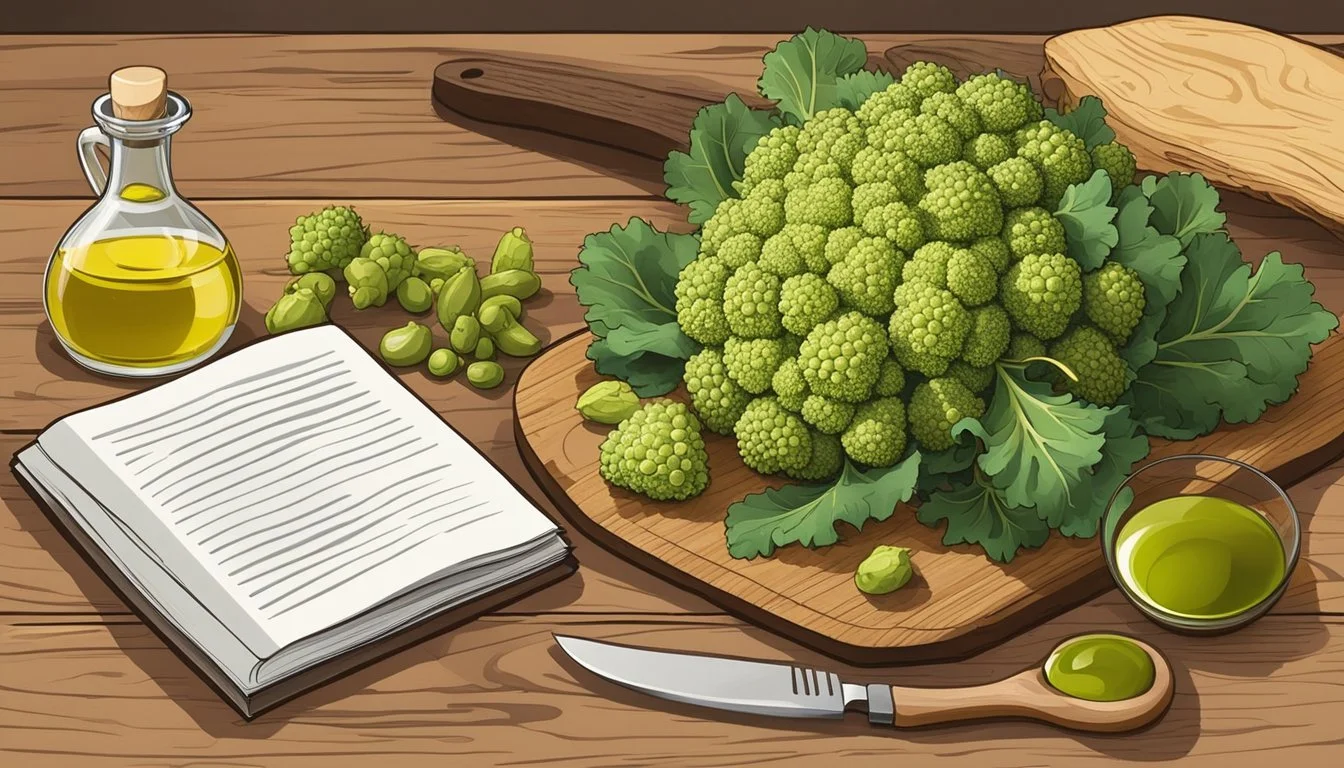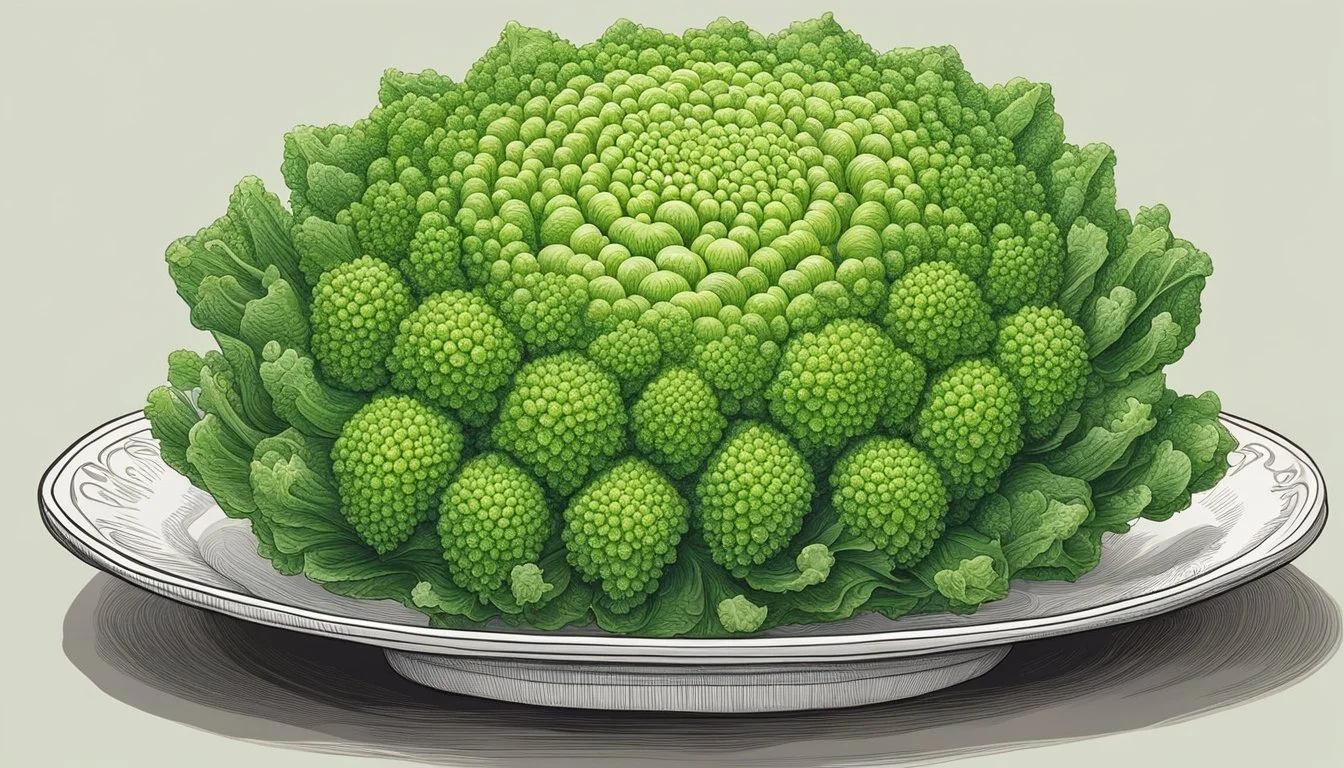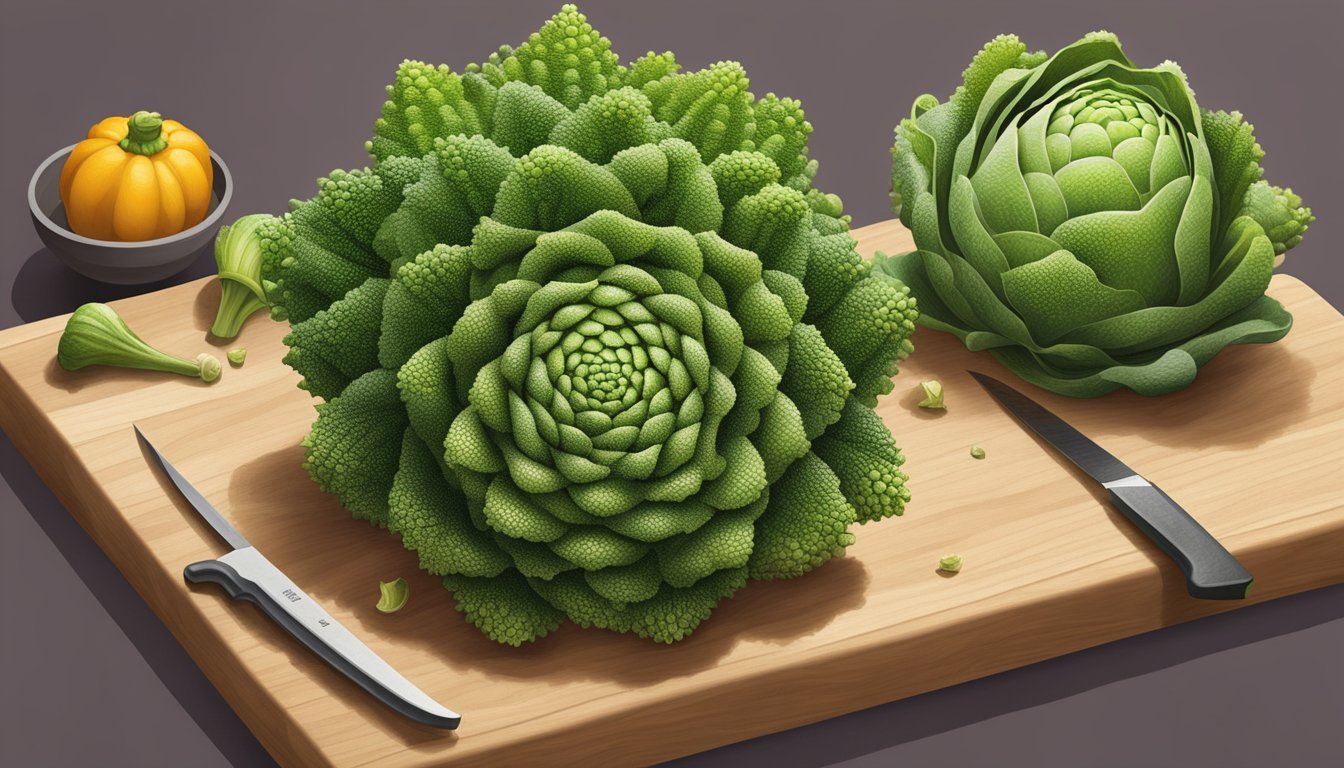How do you eat a Romanesco?
Simple Preparation and Cooking Tips
Romanesco is a striking vegetable that captures the eye with its natural fractal pattern and vibrant green color. Part of the Brassica family, it shares a close kinship with cauliflower (how long does cauliflower last?) and broccoli, yet offers a distinct taste and texture that sets it apart from its more familiar relatives. Its flavor profile is often described as a subtle blend of the nutty and earthy notes found in cauliflower with the slightly peppery qualities of broccoli. Whether served raw or cooked, Romanesco provides versatility and nutrition for a variety of dishes.
When it comes to preparation, this peculiar vegetable can be handled much like its cruciferous counterparts. Eating Romanesco raw in salads or as part of a crudités platter allows its crisp texture to shine, complemented by a dip or dressing that can accentuate its unique taste. When cooked, Romanesco's flavors are enhanced and its texture softens. It can be roasted, steamed, or sautéed with garlic and olive oil for a simple yet delicious side dish. Romanesco is also a delightful addition to stir-fries, pasta dishes, quiches, (What wine goes well with quiche?) and soups. Care should be taken not to overcook it, as the ideal texture that is both tender and slightly crunchy is a hallmark of this vegetable's charm.
When storing Romanesco, it should be kept in a plastic zip-top bag in the refrigerator, uncooked, and unwashed until ready to use. It's best when it's fresh, typically within a week of purchase, after which it can start to lose its quality. Before cooking, a rinse under cold water is sufficient to clean the florets, and then it's ready to be incorporated into any recipe of choice.
Exploring Romanesco
Romanesco, often referred to as Roman cauliflower or Romanesco broccoli, is a striking vegetable that deserves attention for its unique characteristics and culinary versatility. This section uncovers its identity and compares it with its cruciferous relatives.
Defining the Romanesco
Romanesco is an edible flower belonging to the Brassica family, which also includes broccoli, cauliflower, and cabbage. It is characterized by its vibrant chartreuse color and a captivating fractal pattern that makes it a visual standout. Romanesco is not just a feast for the eyes; it's esteemed for its flavor which, when cooked, offers an earthy and nutty taste.
Romanesco vs. Broccoli and Cauliflower
Although Romanesco shares a close relationship with broccoli and cauliflower, there are distinguishing features that set it apart:
Color: Romanesco's striking chartreuse hue contrasts with the familiar green of broccoli and the white of cauliflower.
Texture: The texture of Romanesco is more delicate than cauliflower, which tends to hold a denser composition.
Flavor: It offers a milder flavor than broccoli and is less bitter, positioned somewhere between broccoli and cauliflower in taste.
Shape: Romanesco exhibits a unique fractal structure in its florets - a natural iteration of a mathematically inspired pattern.
As a cruciferous vegetable, Romanesco shares the nutritional benefits of its relatives, including fiber, vitamins C and K, and numerous minerals. When preparing Romanesco, it can be used interchangeably with broccoli or cauliflower in recipes, but it's essential to avoid overcooking to preserve its firm texture and subtle flavors.
Selection and Storage
When purchasing Romanesco, one should look for dense, heavy heads with a vibrant color, which indicates freshness. Proper storage is critical to maintaining this freshness until it is ready to be prepared.
Choosing the Best Romanesco
Shoppers seeking the best Romanesco should visit a farmers' market or market where fresh produce is typically available. They must select heads that feel heavy for their size, a sign of density and moisture content. The shape of the Romanesco should be intact, and its spiraled buds should show a uniformity reflective of proper growth. The color should be bright, indicating a fresher vegetable. Any discoloration or signs of withering suggest that the Romanesco is past its prime.
Proper Storage Methods
Once the ideal Romanesco has been selected, proper storage is essential to preserve its quality. It should be stored in the fridge to keep it cool and slow down the degradation process. Wrap the Romanesco in a damp paper towel and place it in a perforated plastic bag for optimal humidity control. This simulates conditions similar to those of a farmers' market, helping to keep it fresh. Check periodically, and consider using it within a week to enjoy its peak flavor and texture.
Preparation Techniques
When preparing romanesco, it is essential to first clean and cut it properly, ensuring it's ready to be either cooked or served raw, according to preference.
Basic Cleaning and Cutting
Before cooking or serving romanesco, one should thoroughly rinse it under cold water to remove any dirt or debris. To prepare the romanesco for cooking or raw consumption, remove the leaves and slice off the bottom of the stem so that it is flush with the florets. Placement on a cutting board is crucial for stability. With a sharp knife, a cook should cut through the middle of the head, tip to base, to divide it into smaller, more manageable pieces. The romanesco can then be broken down into individual florets varying in size, depending on the intended preparation method.
To Cook or Not to Cook
Romanesco's versatility allows it to be enjoyed both raw and cooked. Eating romanesco raw preserves its natural texture and can be a crisp addition to salads. For a cooked approach, romanesco can be blanched to maintain its vibrant color—this involves a brief plunge into boiling water followed by an immediate shock in an ice bath. One may choose to roast it in an oven preheated to a high temperature, usually around 400°F (200°C), for about 10 to 20 minutes, depending on the desired tenderness. Alternatively, romanesco can be sautéed with olive oil and garlic until its texture is tender-crisp, or incorporated into various dishes such as stir-fries, pasta, quiches, or soups. When cooking, it is important to avoid overcooking to maintain its earthy, nutty flavor and appealing texture.
Cooking Methods
Preparing Romanesco involves a variety of cooking methods, each bringing out its unique, nutty flavor. Whether one chooses to roast, steam, or explore other cooking techniques, this vegetable maintains its textural integrity and vibrant green hue when cooked properly.
Roasting Romanesco
Roasting Romanesco in an oven set to around 425°F (220°C) enhances its flavor and gives it a crispy exterior. To roast, one should:
Preheat the oven.
Cut the Romanesco into florets and toss with olive oil, salt, and other seasonings.
Spread the florets evenly on a baking sheet to ensure uniform cooking.
Place in the oven and roast for about 20-25 minutes or until golden and tender.
Steaming to Perfection
Steaming Romanesco allows it to maintain its structure and nutrients better than boiling. The steps for steaming are straightforward:
Fill a pot with a few inches of water and bring it to a simmer.
Place the Romanesco florets into a steamer basket and then into the pot.
Cover with a lid to trap the steam and cook for about 5-6 minutes until tender but still slightly crisp.
Other Popular Cooking Methods
Aside from roasting and steaming, Romanesco can be enjoyed through other culinary techniques:
Sautéing: Romanesco can be cut into small florets and sautéed in a pan with garlic, olive oil, and seasonings until tender.
Microwaving: To quickly cook Romanesco, one may place the florets in a microwave-safe dish, add a splash of water, cover with a lid or plastic wrap, and microwave on high for 2-3 minutes.
Each method has its merit and allows the Romanesco to be incorporated into a plethora of dishes.
Recipes and Pairings
Romanesco boasts a unique, slightly nutty flavor, making it a versatile ingredient in many dishes. From being the centerpiece of a dish to being an accompaniment on the side, it lends itself to various culinary applications, enhanced by its firm texture and earthy taste.
Romanesco as the Star Ingredient
Romanesco can be prepared in ways that highlight its intricate, spiral florets and vivid green color reminiscent of a miniature Christmas tree. A simple yet delicious way to enjoy it is by roasting with olive oil, salt, pepper, and a sprinkle of lemon juice. This method accentuates the vegetable's natural nutty and earthy flavors. For a quick recipe, blanching romanesco and then sautéing it with garlic and parsley offers a delectable taste experience.
Complementary Side Dishes
As a side dish, romanesco pairs well with ingredients that complement its texture and flavor profile. Steamed or sautéed romanesco with a drizzle of olive oil can be served alongside proteins like grilled chicken or fish. It can also be mixed into a kale salad for a delightful winter or summer dish, providing a crunchy, flavorful addition to the leafy greens.
Integrating Romanesco into Main Courses
In main courses, romanesco can be integrated in many ways. It's excellent in stir-fries, combined with a savory sauce, or tossed with pasta for a hearty meal. The florets hold their shape well, making them an ideal ingredient for adding texture to softer components like quiche or soup.
Romanesco in Vegan and Vegetarian Cuisine
Romanesco has a significant place in vegan and vegetarian cuisine due to its hearty texture and rich flavor. It can star in roasted romanesco recipes, where it's seasoned with parmesan (or a vegan alternative), or it can be used as a meat substitute in dishes. Roasted romanesco can be finished with a variety of spices and herbs, allowing it to fit seamlessly into different international cuisines.
Nutritional Information
Romanesco stands out as a highly nutritious vegetable, rich in essential vitamins and minerals. It contributes significantly to a balanced diet, offering a range of health benefits.
Health Benefits of Romanesco
Romanesco is part of the cruciferous vegetable family, which is renowned for its health-promoting properties. It is an excellent source of fiber, which aids in digestion and helps maintain a healthy gut. The vegetable also provides a decent amount of protein, which is vital for muscle repair and growth.
As a healthy vegetable, romanesco is packed with nutrients while being low in calories, making it a suitable addition to weight management diets. It contains vitamins such as vitamin C, which supports immune function, and minerals including potassium, which is essential for heart rhythm regulation. Furthermore, its intricate fractal structure is not just visually appealing but also a testament to its densely packed nutritional value.
Nutritional Facts Per 100g of Romanesco Calories 22 Protein 2.1g Fiber 2.0g Vitamin C 69% of the RDI Potassium 287 mg
It is important to include vegetables like romanesco in one's diet, as they support overall health and contribute to the intake of necessary dietary nutrients.
Serving and Presentation
Romanesco can be transformed into a visually striking and flavorful dish with the proper preparations. Tactful seasoning and careful presentation can enhance this vegetable's geometric beauty and delicate taste.
Enhancing Flavor and Appearance
Romanesco should be served fresh to preserve its crunch and vibrant green colour. To boost flavor, chefs often incorporate lemon, Parmesan cheese, and butter. Here's a breakdown of serving suggestions:
Lemon: A squeeze of lemon juice or a sprinkle of lemon zest can add a tangy, fresh note.
Parmesan Cheese: Grated Parmesan adds a savoury depth that complements Romanesco's nuttiness.
Butter: A pat of melted butter can be drizzled over cooked Romanesco to enrich its flavor.
In terms of seasoning, a simple yet effective combination includes sea salt and black pepper, which should be used sparingly to not overpower Romanesco's subtle taste.
For a hint of additional flavor without the strong pungency of fresh garlic, garlic powder can be a convenient alternative. Sprinkling a modest amount over the Romanesco before or after cooking can enhance its taste.
When roasting Romanesco, wrapping it in aluminum foil can help to steam the vegetable gently, preserving moisture and infusing the flavors of added ingredients like butter or spices. This method ensures the Romanesco remains the centerpiece of the dish while being thoroughly seasoned.
It's crucial to serve Romanesco properly not only to please the palate but also the eye, as its unique fractal structure makes it a visually appealing addition to any plate.
Additional Tips
When preparing Romanesco, one must pay attention to cooking techniques to preserve its texture and vibrant appearance. The following additional tips can help ensure that Romanesco is enjoyed to its fullest potential.
Avoiding Common Cooking Mistakes
Overcooking: To prevent Romanesco from turning into mush, one must be mindful of cooking times. It's recommended to cook:
Roasting: 20-25 minutes at 400°F (204°C)
Steaming: 5-7 minutes until tender
Sautéing: 5-6 minutes over medium heat
It is crucial to check the Romanesco frequently and test for a firm but tender texture to avoid overcooking.
Substitutes and Variations
Substitute Options: If Romanesco is not available or one seeks variety, they can substitute it with alternatives that provide similar textures and flavors:
Broccoflower: Similar texture and taste, can be used interchangeably.
Brussels Sprouts (how long do brussels sprouts last?): Roast or steam as a hearty alternative.
Table for Cooking Times and Methods for Substitutes:
Substitute Roasting Time Steaming Time Broccoflower 20-25 minutes 5-7 minutes Brussels Sprouts 20-25 minutes 6-8 minutes
When substituting, one should adjust cooking times and methods based on the size and density of the alternative vegetable.
Preservation and Sustainability
In the realm of produce like Romanesco, maintaining quality while adhering to sustainable methods is crucial. Extended shelf life ensures minimal wastage, and sustainable farming practices protect the environment during cultivation.
Extending Romanesco's Shelf Life
To prolong the vitality of Romanesco, proper storage is key. They should be kept unwashed in a plastic zip-top bag in the refrigerator. This method can keep Romanesco fresh for approximately one week. When ready to use, rinsing just before preparing it can help maintain its crispness. Avoiding saturation is important; too much moisture can precipitate wilting and spoilage. Purchasing Romanesco in the fall, when it's in season, usually ensures that it retains its robustness, as produce is fresher from the farmers' market.
Sustainable Farming Practices
Sustainable cultivation of Romanesco is beneficial for both consumers and the planet. Farmers that employ techniques like crop rotation and organic farming aid in maintaining soil health and reducing the reliance on chemical pesticides and fertilizers. Additionally, by choosing local and organic Romanesco from farmers' markets or community-supported agriculture (CSA) programs, consumers can support smaller-scale farmers who often follow more sustainable practices. These methods contribute to a smaller carbon footprint and promote biodiversity within agricultural systems.









